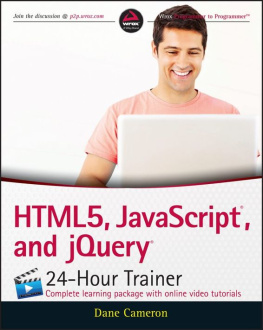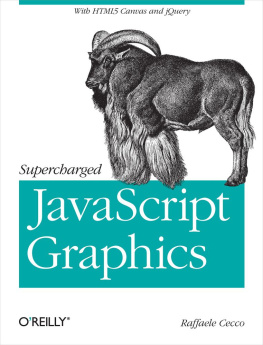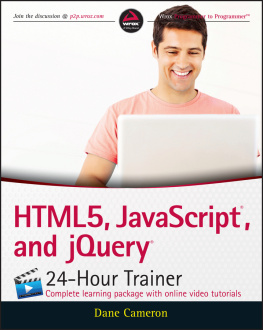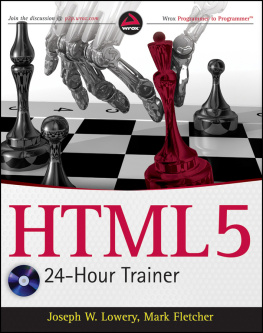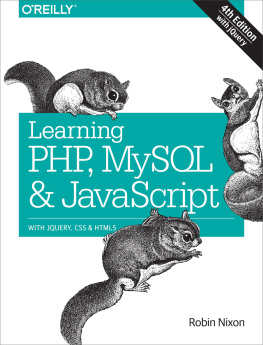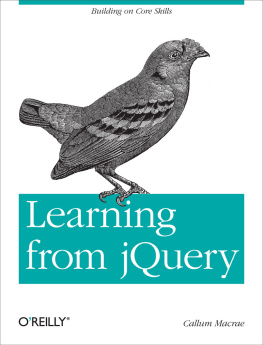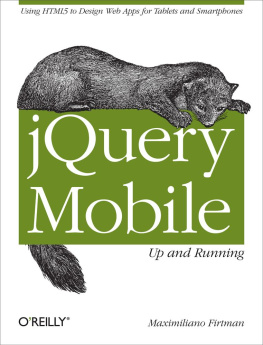Cameron - HTML5, JavaScript, and jQuery 24-hour trainer
Here you can read online Cameron - HTML5, JavaScript, and jQuery 24-hour trainer full text of the book (entire story) in english for free. Download pdf and epub, get meaning, cover and reviews about this ebook. year: 2015, publisher: John Wiley & Sons, genre: Computer. Description of the work, (preface) as well as reviews are available. Best literature library LitArk.com created for fans of good reading and offers a wide selection of genres:
Romance novel
Science fiction
Adventure
Detective
Science
History
Home and family
Prose
Art
Politics
Computer
Non-fiction
Religion
Business
Children
Humor
Choose a favorite category and find really read worthwhile books. Enjoy immersion in the world of imagination, feel the emotions of the characters or learn something new for yourself, make an fascinating discovery.
HTML5, JavaScript, and jQuery 24-hour trainer: summary, description and annotation
We offer to read an annotation, description, summary or preface (depends on what the author of the book "HTML5, JavaScript, and jQuery 24-hour trainer" wrote himself). If you haven't found the necessary information about the book — write in the comments, we will try to find it.
HTML5, JavaScript, and jQuery 24-hour trainer — read online for free the complete book (whole text) full work
Below is the text of the book, divided by pages. System saving the place of the last page read, allows you to conveniently read the book "HTML5, JavaScript, and jQuery 24-hour trainer" online for free, without having to search again every time where you left off. Put a bookmark, and you can go to the page where you finished reading at any time.
Font size:
Interval:
Bookmark:
THE BASIC TECHNOLOGIES BEHIND THE WEB are now almost a quarter of a century old. HTML dates all the way back to 1993, the same year the first popular web browser, Mosaic, appeared on the scene.
You may have thought, therefore, that the technologies behind the Web would have entered a comfortable middle-agestill improving around the edges maybebut not innovating with the pace and excitement of their early years.
In fact, nothing could be further from the truth. The last ten years have been some of the most exciting and innovative in the history of the Web, and this pace of change is continuing to accelerate. As a result, the Web is no longer the preserve of simple websites. It is the realm of web applications: feature-rich applications that just happen to run inside web browsers.
A whole new class of computing devices has accentuated the pace of this change. Web browsers are no longer the preserve of desktops and laptops: They now appear on a myriad of devices from smart phones to smart TVs. The fact that web browsers are the one universal feature across these diverse devices has served to enhance the appeal of browser-based web applications: You write the web application once, and your users use it from any device they choose.
This innovation of the last decade did not happen by accident. Various standards committees have been hard at work for more than a decade devising a set of standards that have been grouped under the umbrella of HTML5. These standards have now made their way into all the major web-browsers.
If you are familiar with HTML, the term HTML5 may simply imply a new version of the HTML markup languagewhich may be interestingbut not revolutionary. In fact, HTML5 is far more than a markup language; it is a set of programming APIs, implemented by browsers, that allow web pages to perform tasks that had never before been possible.
For example, it is now possible for an HTML page to store massive amounts of data in your browser, operate without a network connection, request more information from a web server as and when it needs it, and perform complex computations in the background without interfering with your browsing experience.
The goal of this book is to teach you how to write web applications. In order to achieve this, you need to understand more than HTML5. You need to understand a set of related technologies. More importantly, however, you need to understand how these technologies work together.
HTML5, for instance, is closely tied to JavaScript. In many cases, if you want to use HTML5, you need to do so through a JavaScript API. It is thus not possible to master HTML5 without also mastering JavaScript.
JavaScript is also approaching middle age, yet it too continues to evolve in tandem with HTML5. Historically considered something of an oddity, JavaScript has turned into a rich and expressive programming language, capable of much more than the simple tasks (such as form validation) that it was consigned for so many years.
A large part of the appeal of JavaScript is the myriad of enormously useful, freely available libraries that are written in the language. Chief among these is jQuery, a JavaScript library that has taken on a life of its own and come to redefine the way programmers add dynamic features to their web pages. You can write web applications without learning jQuery, but your code will lack the conciseness of expression the jQuery library affords.
Finally, in order to produce visually appealing web applications you will need to learn Cascading Style Sheets. Just like all other web technologies, CSS also continues to grow and evolve, and the newest version of CSScalled CSS3means that web pages can achieve dazzling visual effects.
This book is for anyone who wants to learn how to build dynamic websites and web applications using standards-based technologies.
You may have experience with HTML4, although that is not required because the early lessons provide an in-depth look at all of the most important features of HTML. More experienced readers may, on the other hand, choose to skip these lessons.
This book contains many code examples based on JavaScript. It is expected that you have some programming experience before reading this book, although not necessarily with JavaScript. If you have no experience with programming, you may want to prepare with some online tutorials and exercises before beginning.
Finally, this book is for programmers who want to learn by doing.
HTML5 is a versionless standard. The specifications behind HTML5 continue to grow and evolve, but this evolution is not matched with official or versioned releases.
As such, this book does not focus on a specific version of HTML5; instead, it focuses on the aspects of HTML5 that have achieved widespread adoption in all of the most common web browsers.
The JavaScript language does contain versioned releases, but unlike most programming languages, you have no control over the version that your users will choose because this is a byproduct of the browser that they select. As a result, this book will not focus on a specific version of JavaScript: It will focus on the features that are universally available in all the major browsers.
This book will use a number of JavaScript libraries that are subject to change over time. Whenever a library is used, a specific version will be specified. In many cases, a more recent version of the library will work without issue, although the code is only guaranteed to work with the specified version.
This book is intended as a hands-on guide. Each lesson includes code and exercises that you can follow along with, and even augment if you choose. It is important that you follow along with these exercises because it is this process that will consolidate your understanding of how the technologies really work.
This book is split into five sections. The first two sections are intended to be read in order because they provide you with the foundation knowledge required to add more complex functionality. The remaining three sections can be read in any order you choose.
The first section of the book provides an introduction to HTML and CSS and looks at how to build static web pages with these technologies. By the end of this lesson, you will have a solid foundation on which to start adding more complex functionality.
In the second section, you turn your attention to JavaScript and jQuery, and look at how a static web page can be converted into a dynamic web application.
The third section of the book looks at the multimedia capabilities of web browsers and how you can harness these through technologies such as the Canvas API and CSS3.
Once you have an understanding of JavaScript, you can turn your attention to the HTML5 APIs that allow you to store data inside the browser, access data from web servers, and execute tasks on background processes. It is these features that truly turn your website into a feature-rich web application.
In the final section of the book, you will turn your attention to mobile devices and address the question of how you can convert your web application into a mobile web application that functions on any mobile device your users may choose to use.
A large portion of this book is structured around the development of a sample web application. If you choose to skip a lesson, you will therefore need to download a completed version of that lesson's web application before starting the next lesson.
Font size:
Interval:
Bookmark:
Similar books «HTML5, JavaScript, and jQuery 24-hour trainer»
Look at similar books to HTML5, JavaScript, and jQuery 24-hour trainer. We have selected literature similar in name and meaning in the hope of providing readers with more options to find new, interesting, not yet read works.
Discussion, reviews of the book HTML5, JavaScript, and jQuery 24-hour trainer and just readers' own opinions. Leave your comments, write what you think about the work, its meaning or the main characters. Specify what exactly you liked and what you didn't like, and why you think so.

